You Need These Beginner-Friendly Water Sports On Your Summer Bucket List
"Hearst Magazines and Yahoo may earn commission or revenue on some items through these links."
If your workouts are keeping you on dry land, you’re seriously missing out. Water sports and activities are a great way to get moving, have fun, and enjoy lakes, rivers, and oceans all year round, but especially in the summer.
Swimming, surfing, snorkeling, and all of the other ways you get active in the H2O have serious mind-body payoffs too. Not only do water sports decrease your risk of chronic diseases (like heart disease and diabetes) but they've also been shown to offer a significant mental health boost. There’s a reason sound machines have multiple water options, it’s instantly calming.
This has all certainly been true for former pro surfer Jessi Miley-Dyer, head of competition for the World Surf League. “I truly believe that water sports are cleansing. I always feel like I’m a better version of myself when I get out of the water," she says. “I started surfing when I was young and I remember just loving being at the beach. Today, surfing has become an escape; when I surf, I don’t have to worry about anything else going on in my life or in the world.”
Beginners can certainly reap these benefits. Whatever gets you in the water works, Miley-Dyer says. Whether your comfort and skill level is more lazy river or adrenaline flowing adventure, one of the following water sports is guaranteed to fit your vibe and lifestyle.
Here are the 20 best water sports—and the top spots to try them.
1. Windsurfing
Difficulty: Moderate
Windsurfing is one of those sports that you can definitely try out if you’re a beginner as long as you take a class at a windsurfing or sailing school. You'll stand on a surfboard holding the attached sail and zoom along the water. (Easier said than done, depending on the wind and waves around, but so worth it.)
Where to try it: Lake Garda, Italy, boasts two reliable winds making its water world class for windsurfing. The stronger early morning wind, dubbed Peler, blows north to south. During the afternoons a medium intensity wind known as Ora, blows in the opposite direction. Book a lesson at one of the lakeside windsurfing schools to get the basics. Rest easy, there’s also no chance of drifting out to sea because you’re in the middle of a lake, plus wineries and Northern Italian fare await ashore to refuel after.
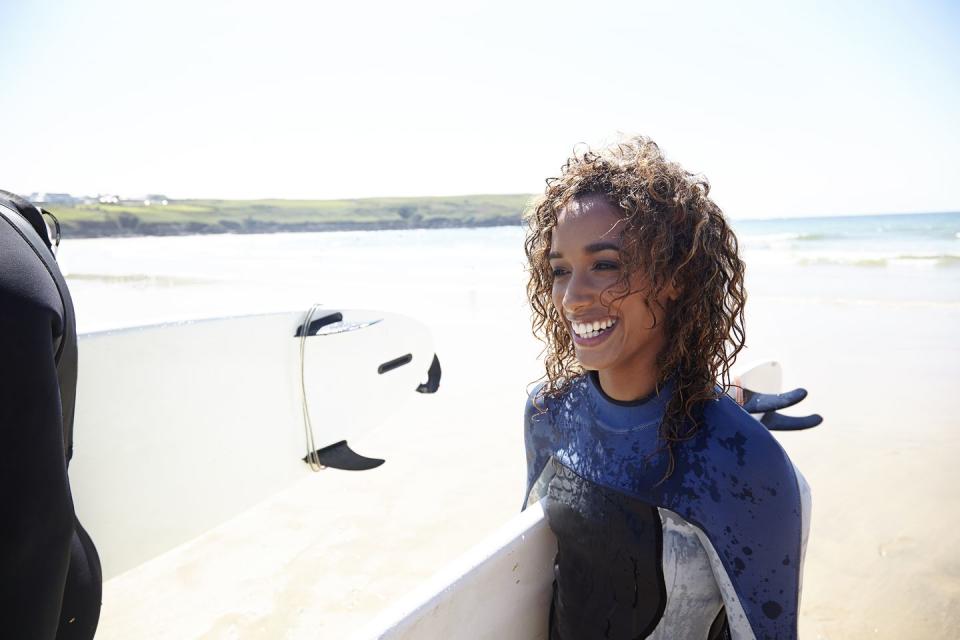
2. Surfing
Difficulty: Moderate
The Blue Crush is real. If you want to enter your surfer girl phase, there’s no reason why you can’t catch some waves of your own. Never surfed before? Most beach communities have surf schools that offer lessons for all levels.
Otherwise, find friends who are comfortable in the waves to take you out. “It always helps when it’s not just you by yourself because starting out can be frustrating,” explains Miley-Dyer. “It’s like having a gym buddy to support and motivate you, who can also help you in case you get into trouble.”
Where to try it: Grab your workout buddies for all-women surf camp in Costa Rica with SwellWomen. At Jungle Lodge the waves offer the perfect break for all levels. There are different sections to match your ability and comfortable 83-degree water for paddling and inevitable falls.
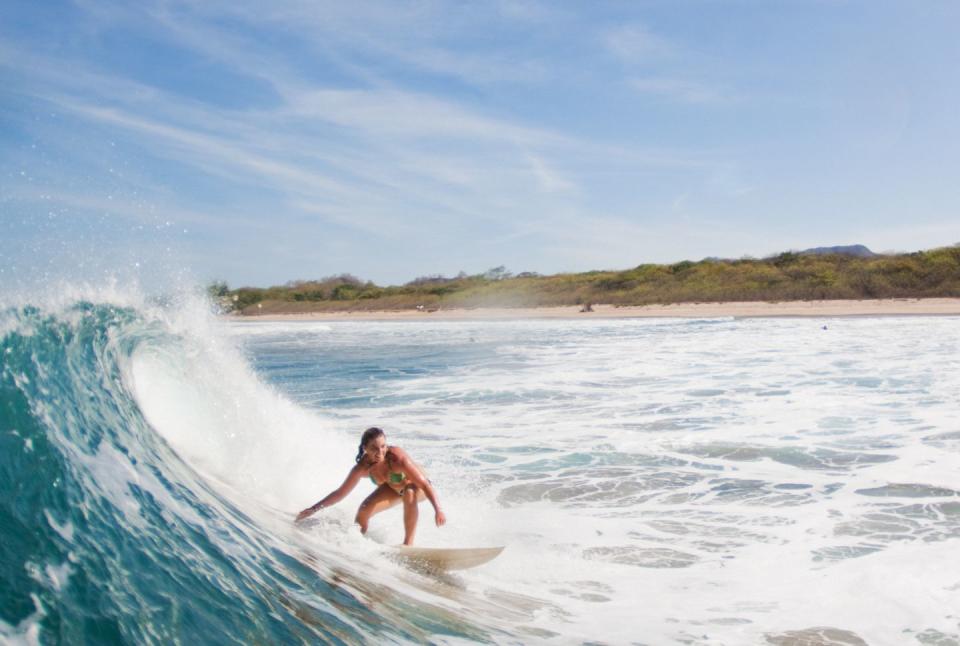
3. Boating
Difficulty: Beginner
If you read the “beginner” status and made a quick mental note of the fact that you don’t actually own a boat, don’t worry. You can find all sorts of rentals in pretty much any community near a body of water—and if you don’t want to take on any waves (don't blame you there!), you can always opt for a lake or bay. Check out Discover Boating to learn more about boating, rentals in your area, and even safety practices.
Where to try it: Utah's Lake Powell is a boating mecca. In the Glen Canyon Recreation area, you'll find all kinds of boats (speed, house, pontoon, and more) for exploring the desert region. Rent one at the marina and cruise around admiring the rock formations.
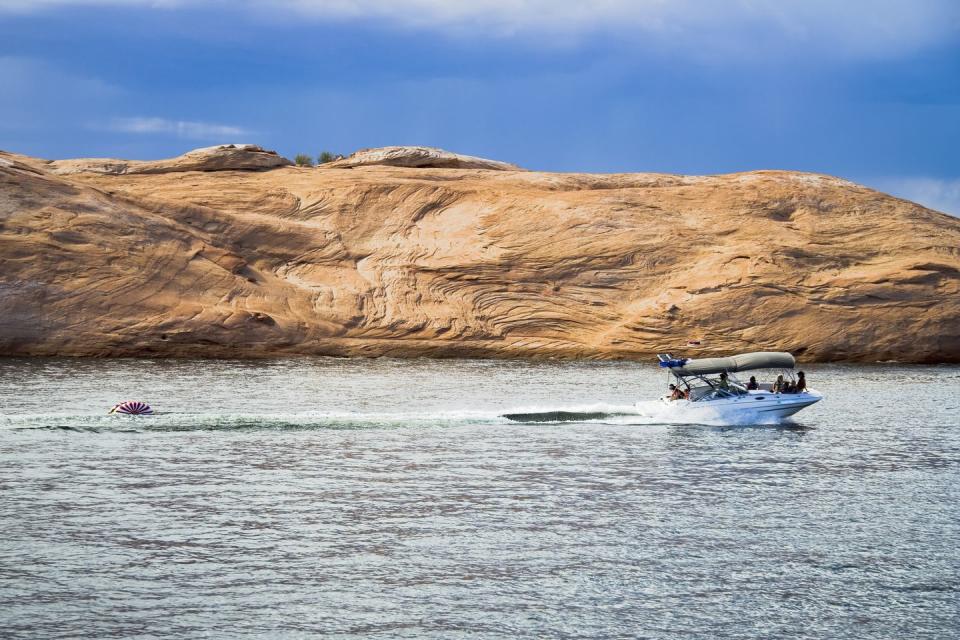
4. Wakeboarding
Difficulty: Moderate
This water sport is a high-adrenaline mashup of surfing and snowboarding. Feet are strapped into a wake board with bindings, like a snowboard, and then you can hit it pulled behind a boat or in a specialty lake park with a cable system, skimming the surface of the water or flying above it doing flips and other tricks.
After you stalk the World Wake Association and feel totally inspired to get boarding, know this: Once you master the first, most difficult step—standing—it all gets so much easier.
Where to try it: No boat, no problem. You can try wakeboarding at AREA47 adventure park in Ötztal, Austria surrounded by stunning peaks. The lake boasts a cableway to tow up to six boarders in a loop with optional freestyle features, turns, and more to keep you on your toes. Don’t worry, the cable runs slower for beginners in the mornings and lessons are also offered to get anyone up to speed.
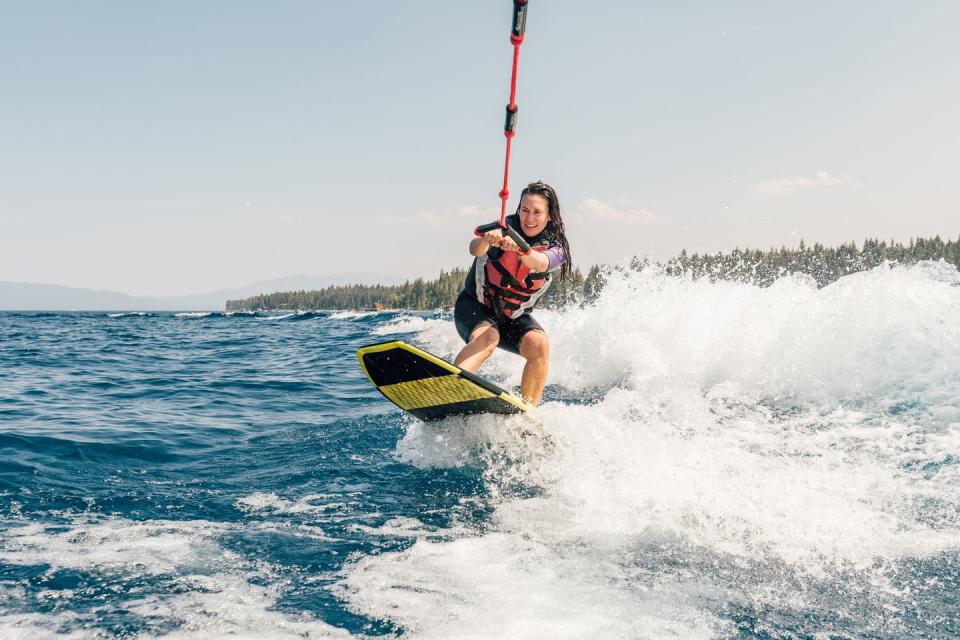
5. Skimboarding
Difficulty: Moderate
You may remember skimboards as those funny-shaped, foam-topped boards with wooden bottoms that teenagers always seem to be messing around with at the beach. If you’re going to a beach with a large, flat slope, it's a perfect activity. While you can definitely find some pros who take their boards right into the waves, you can totally stick to the shoreline (like in this video, but maybe without the flip at the end!).
Where to try it: There's no better place to try skimboarding than where the sport got its start in Laguna Beach, California, and Victoria Beach. Here, the waves break close to the shore ( "shore break"), which lets you hop on your board and play.
6. Bodyboarding
Difficulty: Beginner
Don’t sleep on bodyboarding (a.k.a. boogie boarding) just because you did it as a kid—it’s truly fun for all ages. The best part? You can truly make it as adventurous as you want. Stick to knee-deep waves or kick out (swim fins come in clutch here) to grab the big swells.
This is also a great place to start if you want to surf but feel intimidated since it allows you to get familiar with the board and the ocean, says Miley-Dyer.
Where to try it: Ideal bodyboarding beaches are sandy and free of rocks and coral, so you don't have to worry about taking a tumble. Go to Maroma Beach in Mexico's Riviera Maya to catch some beginner-friendly waves with resort-provided boogie boards.
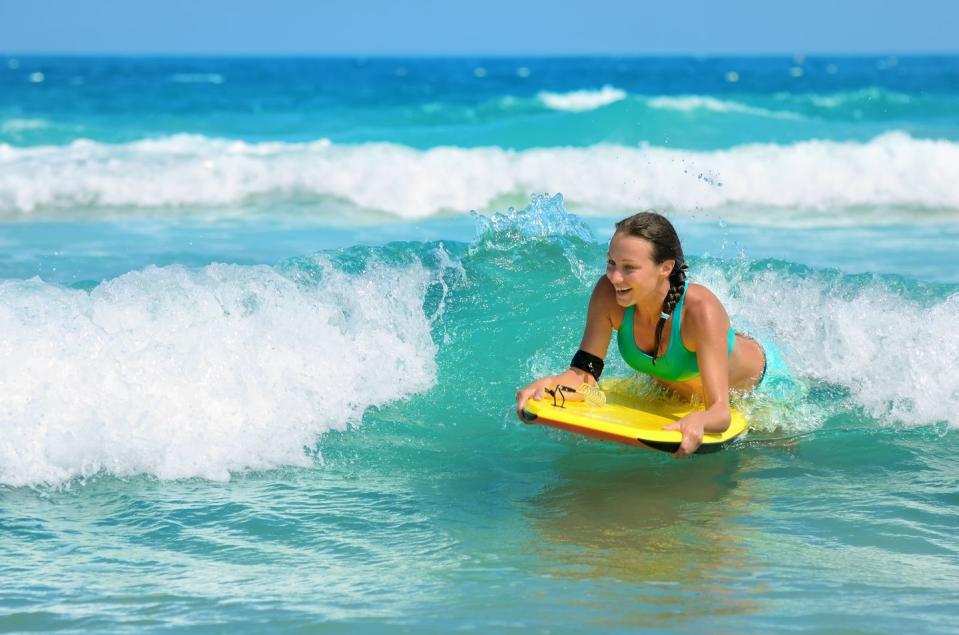
7. Kneeboarding
Difficulty: Beginner
This activity is super popular on lakes, and for good reason: It’s not as technically difficult as wakeboarding, but it’s still so much fun. (Yep, instead of standing, you just kneel!) Of course, it does require a friend and a boat to pull you, but from there you can pretty much learn on-the-spot.
Where to try it: Head straight to landlocked Nebraska and its largest reservoir, Lake McConaughy, to get a taste of kneeboarding. Lake McConaughy State Recreation Area boasts 30,000 surface acres perfect for speeding behind a boat. Boat and gear rentals are easy to find in one of the marinas.
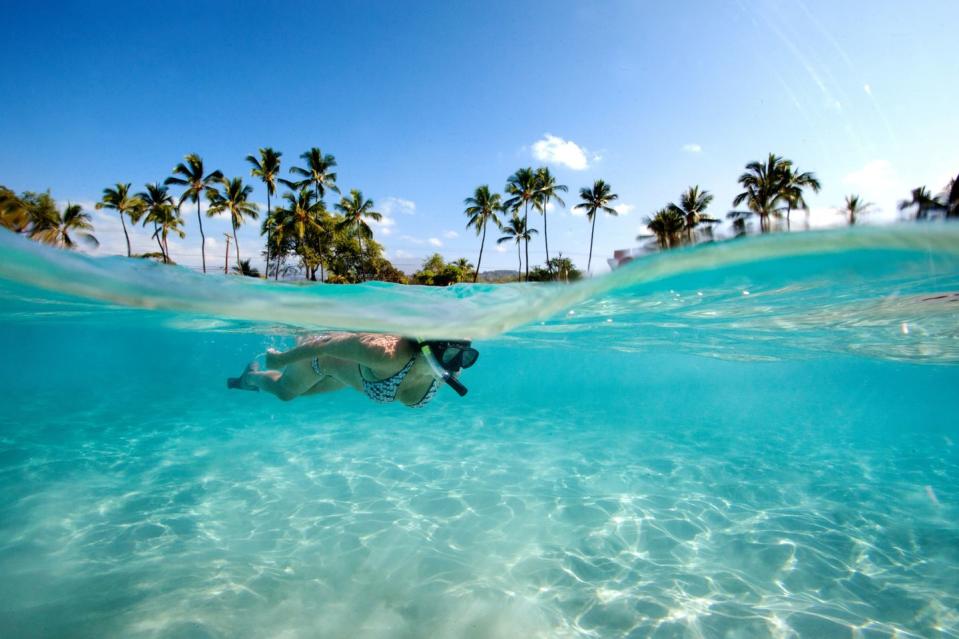
8. Snorkeling
Difficulty: Beginner
Don’t you dare sleep on snorkeling, especially if you’re visiting a new, scenic beach. It’s truly the best way to get a glimpse of the aquatic life below without disturbing the ecosystem. If you happen to be staying at a resort, call and ask if they provide free gear to guests (they often do). Otherwise, you can rent the snorkeling basics at most water sport shops. Just don't forget the reef-safe sunscreen!
Where to try it: Curacao is known for its marine life and rich coral reefs. You can access plenty right off the shores if you bring your own snorkel, mask, and fins and no tour required. There aren’t strong currents, so waters are gentle for beginners to float around through schools of fish and bright coral.
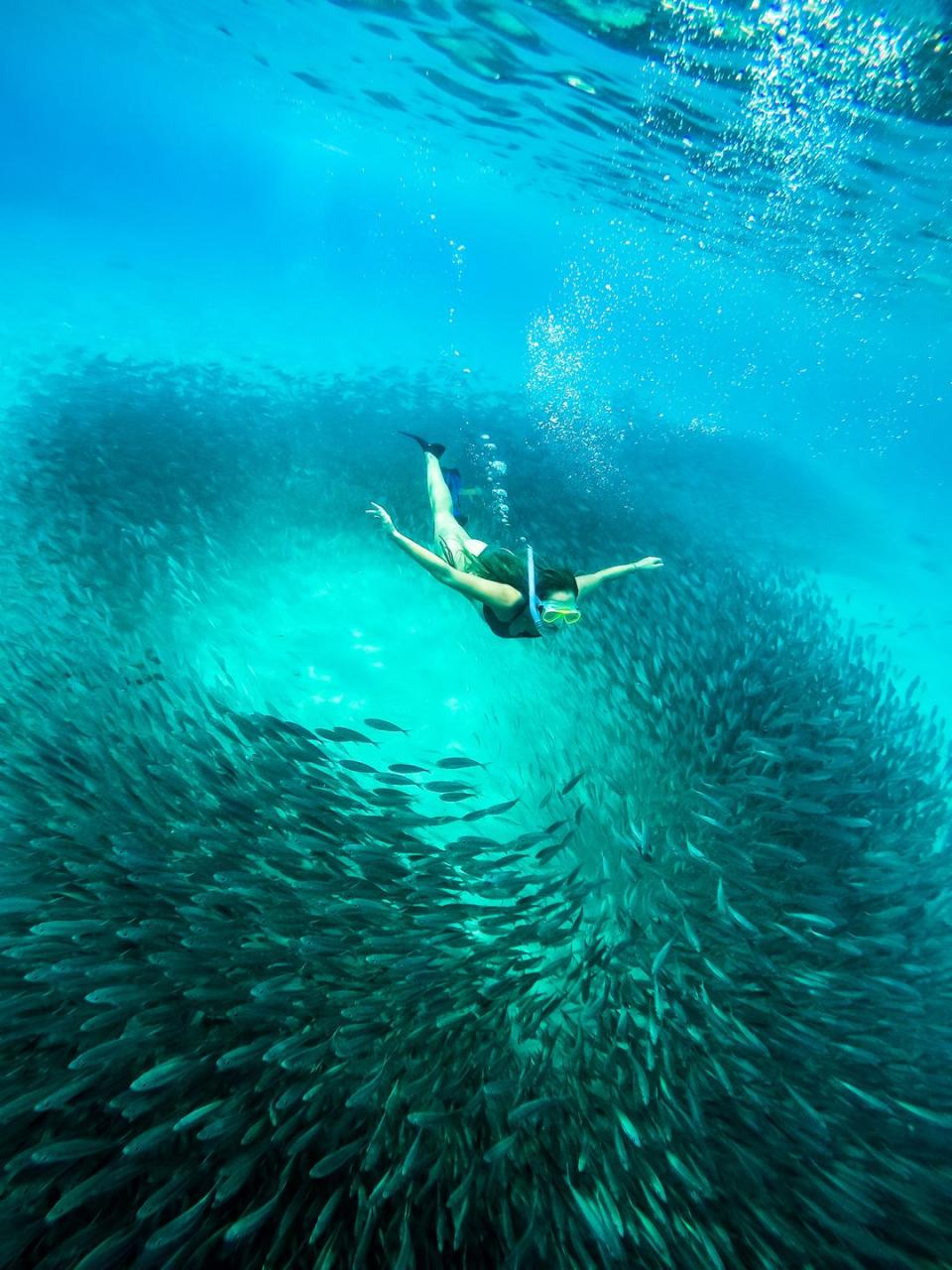
9. Scuba Diving
Difficulty: All levels
Scuba diving can definitely be suitable for all levels because anyone who wants to try has to complete a training class. Scope out the National Association of Underwater Instructors to find a quality instructor. From there, they'll teach you all about the equipment and breathing techniques required to explore the depths of ocean.
Where to try it: Bonaire is known as the “diver’s paradise” thanks to thrilling sights right from shore. There are more than 85 dive sites in the island's surrounding turquoise seas, and 54 of them are easily accessible off the shore. The waters are calm and clear so you're able to see all the marine life. No experience is required either, as dive operators offer one-day intro courses for certification.
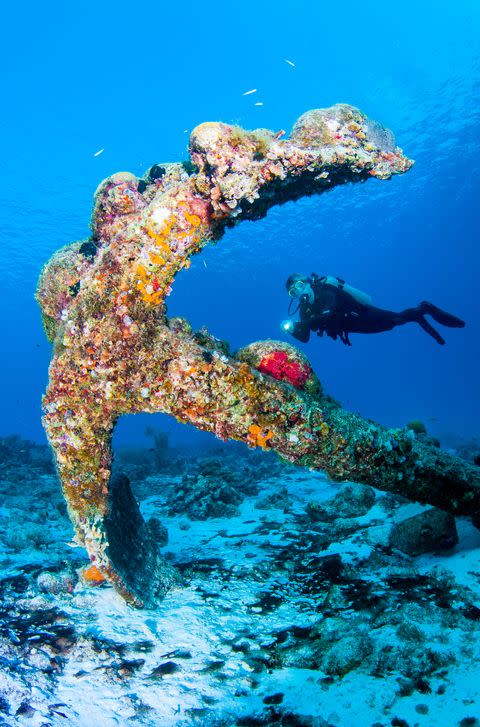
10. Snuba Diving
Difficulty: Beginner
Don’t want to set aside hours of your time to get scuba certified? Enter snuba diving. This activity allows you to dive much deeper than you would free diving or snorkeling (as far as 20 feet) thanks to an air supply that remains above the water and floats along with you. This way, you don’t have to worry about oxygen tanks and breathing techniques.
Where to try it: The big island of Hawaii has multiple snuba offerings, which executive health and fitness director Jacqueline Andriakos described as"the perfect foray into underwater adventure."
"It took a few minutes to get used to breathing through a mouthpiece and learning how to equalize (which involves popping the ears)," she added. "Snuba is an excellent prerequisite that really does feel similar to real deal, albeit easier, less scary, and way more beginner-friendly."
Pop on over to SNUBA's website for more opportunities to try it on your next vacay.
11. White Water Rafting
Difficulty: All levels
If you’re looking for a jolt of adrenaline, white water rafting is the way to go. Not only will you be able to explore nature from the vantage point of a rushing river, but you’ll also be accompanied by a guide to keep you safe. Plus, it's a great activity for families or groups of friends.
Where to try it: North Carolina's Nantahala Outdoor Center employs multiple Olympians to lead everything from gentle float trips to high-octane class IV rapids. Raft the thanks its U.S. Forest Service permit, NOC can take adventurers through both public and private lands. Also in the state is the U.S. National Whitewater Center, the official Olympic training ground for whitewater slalom racing. Here, anyone can take lessons and learn alongside the very best.
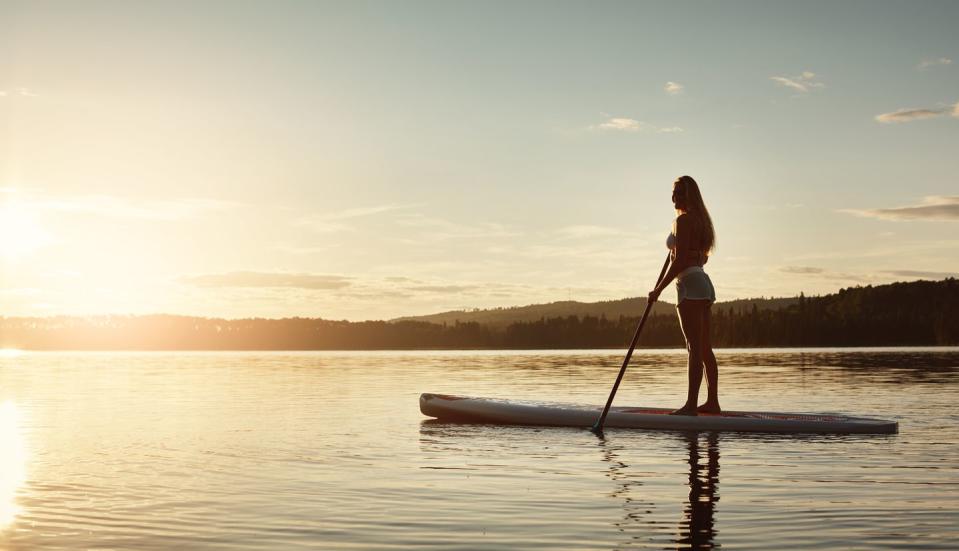
12. Stand-Up Paddleboarding (SUP)
Difficulty: Moderate
While paddleboarding may look peaceful from a distance, it’s a great workout for your legs, arms, and core. The Professional Stand-Up Paddle Boarding Association offers up some good tips, including how to learn to stand up on the board and stay up (which takes serious core strength and stability). Of course, though, you can always float along in a seated or kneeling position until you're ready to stand.
Where to try it: Head to the British Virgin Islands and the calm waters at Rosewood Little Dix Bay on Virgin Gorda for a beginner-friendly SUP experience. The reef covers much of the bay, so there are no waves to throw your board off balance. You can paddle above sea turtles, schools of fish, coral, and sting rays in the protected cove.
13. Water Aerobics
Difficulty: Beginner
For those that want to integrate the pool into their workouts, water aerobics are a great way to go. Classes are offered at lots of local pools (as well as resorts) and are a great low-impact option for those overcoming injuries or looking to switch up your resistance training. It's not just flailing around in the pool to tunes, either. There are many variations including floating yoga, aqua spin, and aqua Zumba.
Where to try it: New York City’s Aqua Studio is the spot to try the surprisingly intense-yet-therapeutic cycling in the water. Hand paddles offer additional resistance and upper-body work while the legs peddle along to the motivating instructor’s beat.
14. Kayaking
Difficulty: All levels
Kayaking is one of those activities that you can really make your own. If you want to explore a resort, many offer up free kayaks that you can hop in and paddle around a lake or in the ocean. Or, you can always start training for rapids if you’re looking for a bit more of an adrenaline rush.
Where to try it: Head to the Hyatt Regency Grand Reserve Puerto Rico to practice your paddling and tour around the protected reserve with complimentary equipment at the resort. Then, take it up a notch and coordinate a tour of the nearby Laguna Grande. Known as a bioluminescent bay or “bio bay,” there are enough microscopic organisms called dinoflagellates to produce bioluminescence (a neon-blue-green "glow-in-the-dark" effect). Fun fact: Puerto Rico has three of the five ecosystems with this appearance in the world.
15. Kiteboarding
Difficulty: Moderate
While kiteboarding requires some equipment, it’s a fun, unique way to enjoy the breeze and the waves. The International Kiteboarding Organization offers an array of beginner classes all around the globe, an impressive stockpile of videos, and an app that allows you to check out good spots where other surfers are having fun.
Where to try it: Turtle Beach on St. Kitts provides a topnotch learning environment through St. Kitts Water Sports offering private or group lessons. The combination of steady cross onshore winds and calm shallow water mean even beginners can progress fast. Turtle Beach is an uncrowded, long white sandy beach, so you don’t have to constantly worry about sailing into other riders or another kite entangling yours.
16. Water Polo
Difficulty: Moderate
If you love the water and find that you enjoy workouts the most when there’s an element of competition involved, water polo is a fun option. Many recreation centers offer intramural teams, which are a great option for those that are looking to make friends while scoring a full-body workout (ahem, you tread water the entire time and can swim multiple miles in a game).
Where to try it: This is one water sport you can't try solo. Luckily, there are welcoming water polo clubs all over the country. Check out USA Water Polo and filter by location to find one near you.
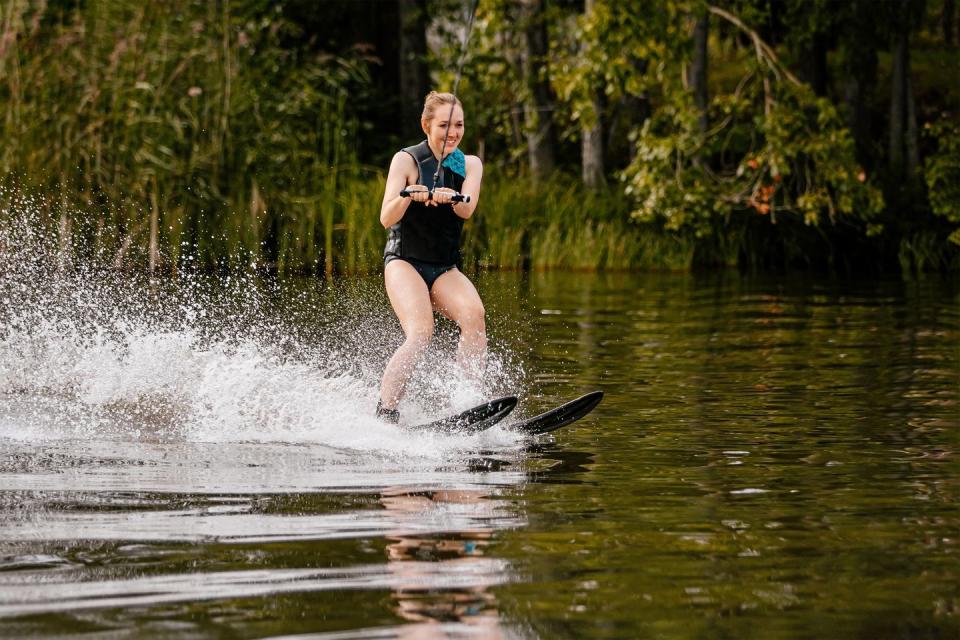
17. Water Skiing
Difficulty: Moderate
Water skiing is a little difficult to get started with (ya know, you need a boat, someone to drive it, and the fortitude to try standing up over and over again), but once you get the hang of it, it feels seriously great. Lakes are definitely the best place to try it out, as you’ll want to avoid waves and wakes (which will have your knees wobbling) as much as possible.
Where to try it: Lake Tahoe is 22 miles long and boasts multiple water skiing schools, so it's an excellent spot to get comfortable with the sport for the first time and improve your skills. Head to Lake Tahoe Water Ski School in South Lake Tahoe for hands-on instruction for the whole fam and all the gear you need included.
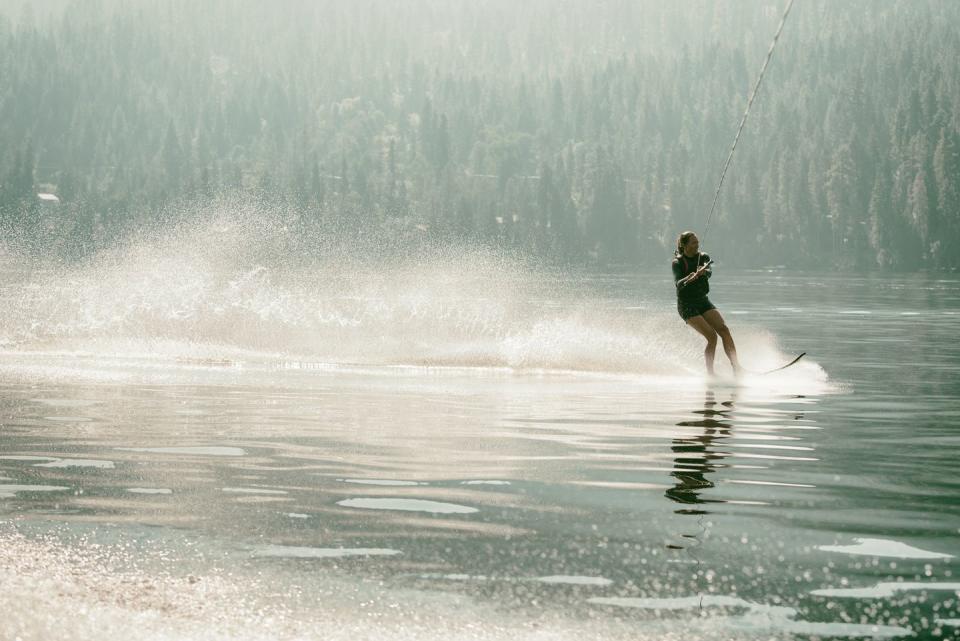
18. Jet Skiing
Difficulty: Beginner
Make sure you’ve skimmed your state boating laws if you’re going to hop on a jet ski in the United States since some states require a license (which is luckily a pretty simple process in most). But whether you're still getting comfortable zipping around or pushing your limits with speed, it's a fun way to explore a lake or surrounding beaches quickly.
Where to try it: A jet ski is an ideal way to zip around Miami’s surrounding beaches and get the prime skyline view from the water and explore one of the Miami sandbars. Book a guided tour with Miami Jet Ski Rental with photo opps, picnic lunch, boating test/certificate, and a bonus boat ride included. (FYI: BoatUS Foundation offers a free online course to come prepared for driving a personal watercraft.)
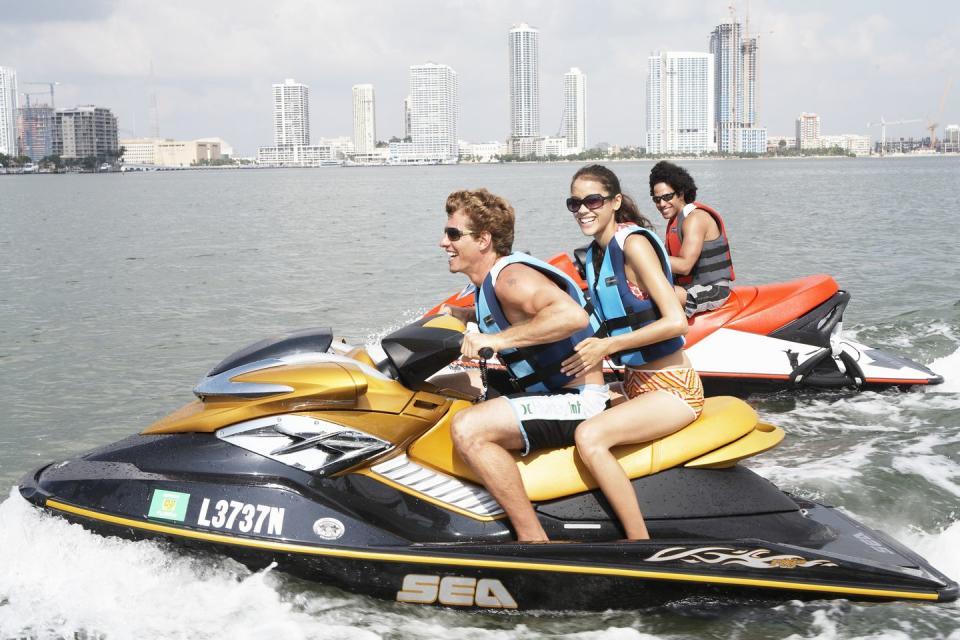
19. Canoeing
Difficulty: Beginner
If this brings back memories of summer camp, just wait until you try it out as an adult! Better yet, pack a picnic and some drinks for a truly fun day out on the water. Canoeing also happens to be a great arm and core workout. Plus, it's just a lovely way to mosey around a body of water for a few hours.
Where to try it: Go big or canoe home at Maui's Wailea Beach Resort. Here a complimentary activity is the adventurous and traditional outrigger canoe. It’s so much more than paddling and soaking in the views, the experience naturally nurtures foundational Hawaiian values of respect, care and collaboration.
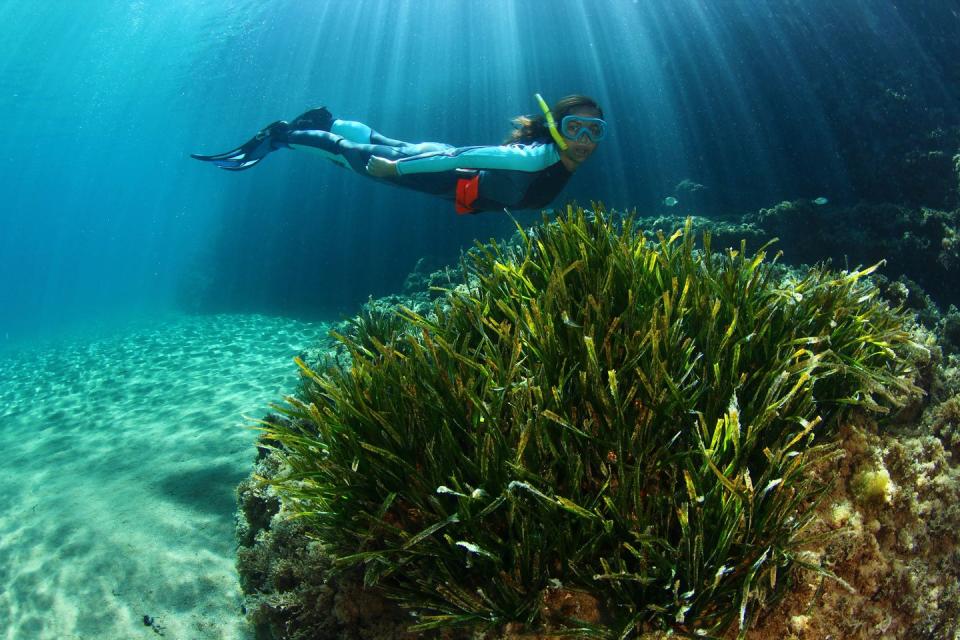
20. Canyoning
Difficulty: Beginner to advanced
Canyoning is becoming a popular adventure sport for exploring rivers, gorges, and canyons (naturally). Often, these spots would be completely inaccessible unless you’re rappelling off a waterfall, jumping into whitewater rapids, or swimming to reach them. It’s not for the faint of heart or anyone who wants to stay dry.
There are routes ideal for all abilities, though. And safety is key with gear including a padded wet suit, lifejacket, helmet, harness, and supportive water shoes. Tour operators, like The Canyoning Company in the UK or Canyon Explorers in New Zealand supply it all for you.
Where to try it: Head straight to the Adventure Capitol of the World (New Zealand) to experience the best of this sport around Wanaka with Deep Canyon. Mellow day trips for beginners all the way up to advanced deep canyons with 25-foot jumps and are available.

You Might Also Like

